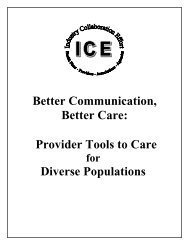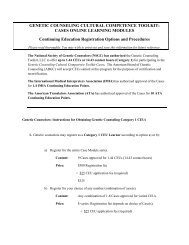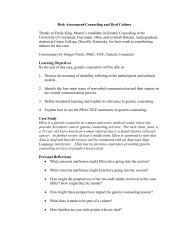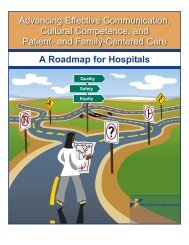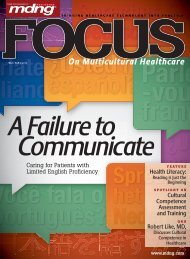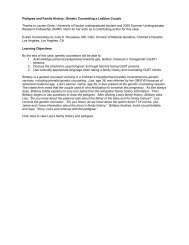APPENDIX KTraditional Safety Net TelephonicInterpreting Project—Dual Head SetAnd H<strong>and</strong> Set InterpretationL.A. Care Health PlanCLAS St<strong>and</strong>ards Met: 1 <strong>and</strong> 4-6See page 12 <strong>for</strong> list of CLAS St<strong>and</strong>ardsISSUE. Language needs of limited English proficiency (LEP) patients enrolled in L.A.Care Health Plan (L.A. Care) exceeded available licensed bilingual providers. As a result,untrained staff members, family members <strong>and</strong> children were being used <strong>for</strong> languageinterpretation during medical visits. Research indicates that sometimes family members,children <strong>and</strong> friends may: 1) not give <strong>the</strong> patient a provider's complete explanation, 2)potentially be embarrassed to admit <strong>the</strong>y do not underst<strong>and</strong> what is being said, 3) find <strong>the</strong>nature of <strong>the</strong> conversation embarrassing, 4) not agree with <strong>the</strong> provider, <strong>and</strong> 5)miscommunicate <strong>the</strong> patient’s message, preferring that <strong>the</strong> provider hear <strong>the</strong>ir version of<strong>the</strong> situation. In addition, family members <strong>and</strong> child interpreters may lack underst<strong>and</strong>ing of<strong>the</strong> medical <strong>and</strong> non-medical vocabulary, whe<strong>the</strong>r in English or <strong>the</strong>ir own language.DISCUSSION. L.A. Care Health Plan (L.A. Care) is a public health maintenanceorganization serving more than 750,000 people in Los Angeles County. L.A. Carecontracts with more than 10,000 health care providers annually, health plans, IndependentProvider Associations (IPA’s) <strong>and</strong> Medical Groups, community clinics <strong>and</strong> hospitals. Thehealth plan serves large populations with limited English proficiency. More than 55percent of patients prefer a language o<strong>the</strong>r than English, including Spanish (45 percent ofenrollees), Cantonese, Korean, M<strong>and</strong>arin <strong>and</strong> 27 o<strong>the</strong>rs.In 2003, L.A. Care developed <strong>and</strong> implemented <strong>the</strong> Traditional Safety Net TelephonicInterpreting Project to eliminate language barriers within <strong>the</strong> patient-provider relationship<strong>and</strong> to reduce errors in medical language interpretation. The project targeted L.A. Care’snetwork of county <strong>and</strong> community clinics <strong>and</strong> provider groups within Sou<strong>the</strong>rn Cali<strong>for</strong>nia.The purpose of <strong>the</strong> project was to assist LEP patients in communicating with <strong>the</strong>irproviders, while reducing <strong>the</strong> administrative time involved in obtaining interpretingservices. When using this system, providers <strong>and</strong> patients need not pass a telephone orheadset back <strong>and</strong> <strong>for</strong>th nor use a speaker phone. Providers <strong>and</strong> patients accessed languageservices using telephonic dual headsets or h<strong>and</strong>sets when a bilingual health care provideror on-site interpreter was not available. The h<strong>and</strong>/headsets are compatible with mosttelephone systems.L.A. Care made equipment, training, <strong>and</strong> technical support available to its participatingproviders at no cost. The dual h<strong>and</strong>set equipment itself was priced at approximately $14 perunit, depending on <strong>the</strong> model <strong>and</strong> make of phone <strong>and</strong> type of h<strong>and</strong>set needed. In addition, alimited number of dual headsets assisted by <strong>the</strong> use of high quality amplifiers wereimplemented in County <strong>and</strong> community clinics which had a need <strong>for</strong> h<strong>and</strong>s freecommunication with patients. The price per unit <strong>for</strong> this model was approximately $178 per54
unit. L.A. Care also covered <strong>the</strong> costs of interpreter services <strong>for</strong> L.A. Care members enrolledin <strong>the</strong> Medi-Cal <strong>and</strong> o<strong>the</strong>r state funded programs.Providers used an internal coding system to designate usage <strong>for</strong> <strong>the</strong>ir patients. L.A. Carepartnered <strong>and</strong> negotiated a contract with Pacific Interpreters to provide interpreter services toall L.A. Care providers involved in <strong>the</strong> telephonic interpreting project. The partneringagency’s capacity included: 1) being HIPAA compliant, 2) having a quality monitoringprocess, <strong>and</strong> 3) operating a disaster recovery center in Engl<strong>and</strong> should delivery of services bedisrupted in <strong>the</strong> United States.BENEFITS/RESULTS. L.A. Care launched this project following pilot testing at three sites,including: 1) a comprehensive care center with multiple clinics within <strong>the</strong> main facility, 2) asafety net clinic, <strong>and</strong> 3) a family care provider group. The majority of calls were <strong>for</strong> languageservices in Spanish <strong>and</strong> Korean. The total cost of telephone interpreter services <strong>for</strong> all threesites during <strong>the</strong> pilot period (June–August 2003) was a modest $939.75. The pilot testshowed that dual h<strong>and</strong>-sets reduced <strong>the</strong> reliance on friends <strong>and</strong> family members <strong>for</strong>interpretation, as well as decreasing <strong>the</strong> use of gesturing <strong>and</strong> o<strong>the</strong>r ineffective communicationmethods. In addition, use of <strong>the</strong> dual headsets <strong>and</strong> h<strong>and</strong>sets reduced L.A. Care’s reliance onexpensive contract interpretation services.LESSONS LEARNED/NEXT STEPS. While many L.A. Care patients initiallyattempted to use family, friends, <strong>and</strong> minors as interpreters during medical visits, <strong>the</strong>ywere receptive in participating with <strong>the</strong> dual headset communication device. Methods ofdiscouraging family members, children <strong>and</strong> friends from serving as interpreters need to bedocumented more clearly in <strong>case</strong> studies, emphasizing evidence-based research <strong>and</strong> bestpractices <strong>for</strong> all languages in use in <strong>the</strong> health plan.WHO TO CONTACT. For more in<strong>for</strong>mation about <strong>the</strong> Traditional Safety Net TelephonicInterpreting Project, contact Jennifer Cho, Manager of <strong>the</strong> Cultural & Linguistic ServicesDepartment, at L.A. Care Health Plan via email at jcho@lacare.org or at (213) 694-1250 Ex.4327.55



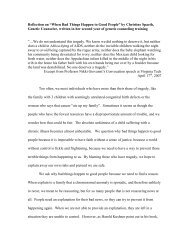
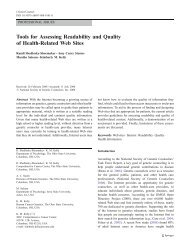

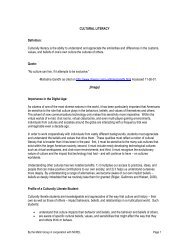
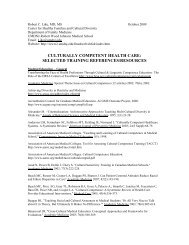

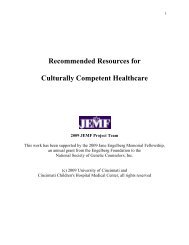
![Breaking Bad News PPT[1] - Genetic Counseling Cultural ...](https://img.yumpu.com/35003134/1/190x146/breaking-bad-news-ppt1-genetic-counseling-cultural-.jpg?quality=85)
